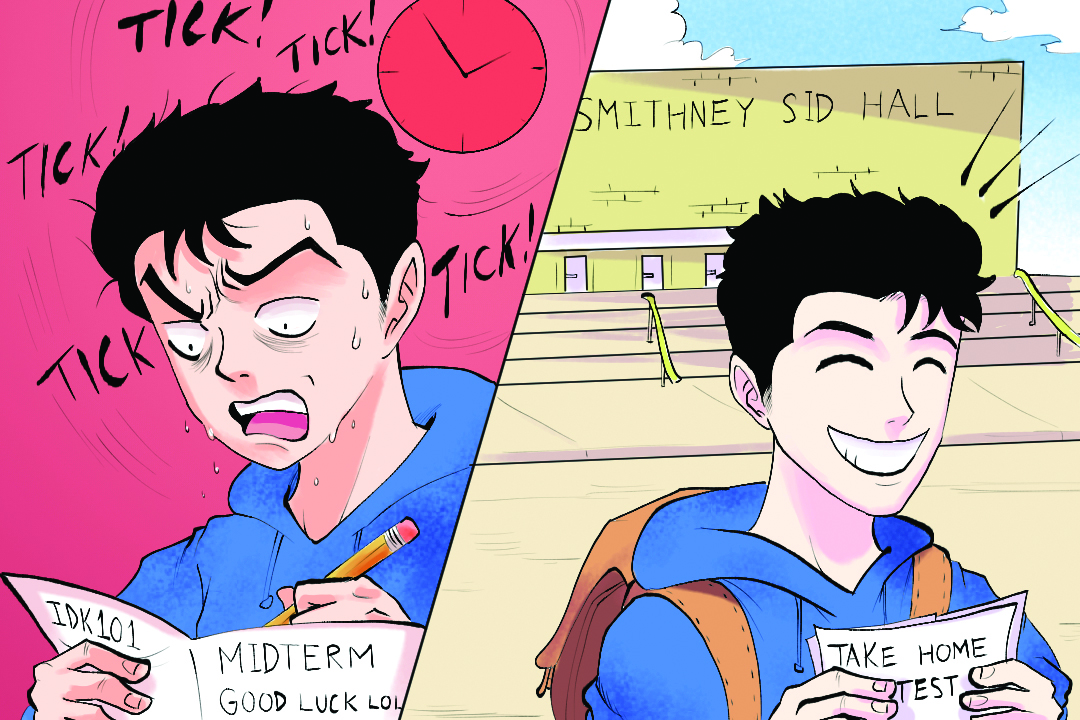With exam season quickly approaching, testing is an area of concern given that many courses have switched to predominantly take-home exams as opposed to timed ones. Having recently completed both forms of testing virtually, I have found that many courses benefit from take-home tests because they allow for application of knowledge beyond rote memorization.
This fall, during midterm season, I had two take-home exams and two timed exams. Although my midterms explored various disciplines, I was able to identify common characteristics between all of my exams of the same format.
Take-home tests may seem to be the ‘easier’ format, but they are challenging in that they tend to place greater emphasis on students’ ability to apply their knowledge as opposed to simply regurgitating concepts they have been taught. According to an article in the Journal of College Science Teaching, take-home exams do a better job of testing “what students can do with what they know.”
It would be a false generalization to claim that all timed exams lack any application questions. However, the type of application questions on timed exams in undergraduate level STEM courses, for example, differ from their arts and humanities counterparts — the difference in question being the variety of answers which can be deemed as ‘correct.’
In undergraduate STEM courses, students’ learning mostly consists of memorization and application of knowledge which must be done a certain way to be correct. These courses generally seek to teach students the facts and laws of the world. Therefore, there is very little variation that each student can have for any given correct answer to a single question. Although they may still be applying their knowledge, students who answer the question correctly will likely have answers that are similar.
If there is only one correct answer, what’s to say that the entire class — whether or not they understand the course content — will not use the surplus amount of time to cheat and get the correct answer? Hence, the rate of academic dishonesty could increase, and cheating would be difficult to detect given that, again, there is only one correct answer.
On the other hand, undergraduate arts, humanities, and social science courses tend to introduce students to theories, events, and worldviews that can be interpreted in a number of different ways. An application question on one of these exams calls upon a student to use their course’s content as a tool in order to provide their personal interpretation of what a ‘correct’ or strong answer would be to an open-ended question. In these cases, academic offences are much easier to detect, given that each student is expected to have a unique answer. One student will find it difficult to unsuspectingly copy an entire essay off of their peers.
In addition to the flexibility take-home exams provide — often allowing students a larger time frame to complete their test — they may cause less stress among students. While stress is not always purely negative, an article from the academic journal Education Sciences criticizes timed exams, stating that they impose “an unnatural pressure on the students that has an adverse impact on their performance.”
Pressure is positive when it prepares students for academic challenges they may face in their future. In many arts exams, however, this pressure tends to be unnatural — and therefore unnecessary, as it does not mimic realistic timeframes that students are likely to find in their future careers.
Outside of the classroom, students will have to compete with many peers who have received the same formal education as them. One of the things that is going to make one student exceptional from the other is their personal ability to gather, interpret, and analyze material in a thorough manner. Although time management inevitably plays a role in their decisions, employers are likely to prioritize a student who has experience doing a thorough analysis over a student who is accustomed to a rushed approach.
Therefore, many courses — especially within the social sciences, arts, and humanities disciplines — can benefit from using take-home exams, even as we fully return to in-person classes. They not only give students more flexibility in completing the exam itself, but also provide professors with an effective way to measure students’ knowledge and ability to apply that knowledge.
Ulfa Ismail is a first-year psychology student at UTSC.


